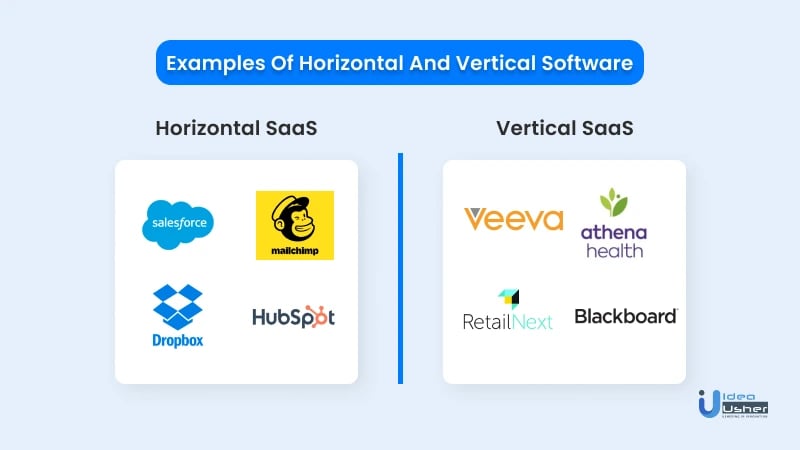Since vertical SaaS aren’t interested in being all things to all customers, they can concentrate on being the best solution to the customers in their industry. In some instances, this makes marketing, selling, and growing a vertical SaaS solution easier than a traditional, horizontal SaaS. However, a small, niche industry can present its niche challenges, whose solutions aren’t as studied and discussed as their horizontal counterparts. This article will explore four common vertical SaaS challenges and provide solutions for overcoming them.
Table of Contents
Vertical vs. Horizontal SaaS
We traditionally think of horizontal SaaS when discussing SaaS providers: SaaS giants like Microsoft, Slack, Salesforce, Zoom, or HubSpot catering to a broad, industry-spanning customer base to help the most customers strengthen their businesses.

Vertical Software is niche, created to service a specific business model or industry. Vertical SaaS providers focus on an industry’s niche paint points, needs, and solutions. White label SaaS specifically built to serve spas, restaurants, education, golf courses, automotive service industries, or insurance are examples of vertical SaaS.
Back to Top
Why Are Vertical SaaS Companies Thriving?
- The SaaS market grows an average of 18% annually.
- Gartner forecasts that end-user spending on SaaS will reach $396 billion in 2021 and grow 21.7% to $482 billion by 2022.
- By the end of 2021, 99% of organizations will be using at least one SaaS solution.
- Nearly 78% of small and medium businesses (SMBs) invest in SaaS options.
.jpg?width=1024&name=Copy%20of%20More%20Blog%20Stats%20(11).jpg)
In terms of SaaS trends, the organizations, publications, and influencers forecasting those trends unanimously agree that 2022 will see an uptick in vertical SaaS. The market size for vertical SaaS platforms has tripled over the last decade. The number of vertical SaaS companies increased by 28% since early 2020 and more Vertical SaaS companies have gone public in 2021 than in any previous year.
Back to Top
Four Common Vertical SaaS Challenges and How to Overcome Them
Legacy Products Dominate the Industry
Because the tech boom initially ignored so many niche industries for “bigger markets,” one or two legacy solutions were often able to gain an overwhelming foothold, becoming industry standards customers are unwilling to part from even if they’re outdated.
Solution:
This solution may seem over-simplistic, but it’s the best approach: showcase how your product is better. It might take some extra marketing or sales efforts, but if you have confidence that your SaaS can outperform the legacy product in every way, you just need to get future customers to see it in action.
Another approach? Provide solutions these legacy programs don’t. What additional value can you add to the vertical you serve that no one else is yet? If your platform has all the same functionality as the legacy platform plus additional solutions your future customers need, there’s almost no way you won’t be gaining new customers.
A white label applicant tracking system is also a great way help vertical SaaS platforms drive additional revenue. Download our Strategic Approach to Revenue Generation for Vertical SaaS report below to see what an ATS can do for your SaaS growth strategy.
Horizontal SaaS Users
As a niche platform services a niche industry, you’ll always come up against potential customers using traditional SaaS platforms because of name recognition and ubiquity. While you may have the best solution for the customers you serve, it’s hard to compete with the resources a company like Zoom or HubSpot has at its disposal.
Solution:
Give your customers an unmatched customer experience. This could mean customer service that goes above and beyond what an overworked junior account executive at a huge corporation can offer, or offering specific customizations, insights, or workflows bigger organizations don’t have the bandwidth or expertise to complete—84% of customers say the experience a company provides is just as necessary as its products and services (and 86% more customers are willing to pay more for a product that comes with a great customer experience).
.jpg?width=1024&name=Copy%20of%20More%20Blog%20Stats%20(12).jpg)
Small Lead Pool
You’re serving a niche industry, which means your lead pool could only get so big in some cases. What happens once you exhaust all the leads, even if you convert them all to customers?
Solution:
72% of businesses say improving customer success is their top priority. Helping customers succeed is even more relevant for SaaS companies because If you help your customers grow their businesses, they’ll need more of your services. What solutions can you offer to help your customers expand their business? What plans do you have to scale alongside them? In the world of SaaS, if your customers grow, you grow.
Vertical SaaS providers may want to look into expanding into similar niches. For example, SaaS created for spas may want to explore breaking into the world of salons, or SaaS for golf courses may want to explore offerings for tennis clubs.
Too Niche
You’re focused on a particular solution for a very niche industry—you’re the best at what you do, but at some point, you risk working yourself into a corner.
Solution:
Increase your functionality! What related solutions can you provide customers? Every new capability you can add that solves a solution for your customers increases your value for them, meaning you can start charging current customers more instead of relying on new ones. Studies find monetization is 4x more efficient than acquisition and 2x more efficient than retention at improving revenue growth.
.jpg?width=1024&name=More%20Blog%20Stats%20(3).jpg)
Back to Top
About HiringThing
HiringThing is a modern recruiting and employee onboarding platform as a service that creates seamless talent experiences. Our white label solutions and open API enable HR technology and service providers to offer hiring and onboarding to their clients. Approachable and adaptable, the platform empowers anyone, anywhere to build their dream team.

.jpg?width=1024&name=Copy%20of%20More%20Blog%20Stats%20(12).jpg)
.jpg?width=1024&name=More%20Blog%20Stats%20(3).jpg)


.jpg?width=1024&name=Copy%20of%20More%20Blog%20Stats%20(11).jpg)

